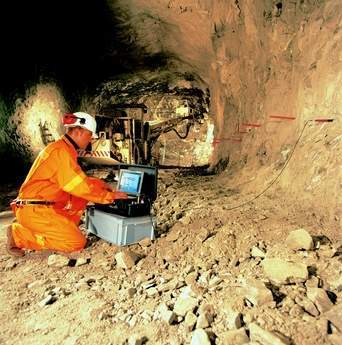Any variation in mechanical rock properties can have a great impact on tunnelling projects. Early warnings ensure that counter-measures and logistical procedures can be planned in good time. The Tunnel Seismic Prediction system could help to avoid and manage the hidden risks inherent in tunnelling.

The use of innovative technology has led to the rapid construction of more complex underground structures. For example the use of tunnel boring machines has resulted in advance rates of up to 20m or more each day, while advanced drill and blast techniques have also played their role.
Underground projects are particularly challenging as there is great uncertainty about what lies ahead of the rock face. The cost, and overall feasibility, of the project is dominated by geology, and every aspect of the geological investigation for tunnelling makes great demands. Therefore the understanding of regional geology and hydrogeology is essential.
Surface investigations can be quite limited due to strongly changing geology conditions; urban areas above the tunnel route; or insufficient resolution. It is possible to obtain information by drilling probe holes but these are costly and considerably delay many tunnel works. Ultimately the safety and progress of a project is based on the assumed knowledge of the rock’s properties ahead of the rock face.
Such information can be gathered through the collection of tunnel seismic measurements which enable continuous prediction ahead of the face. This results in a time gain for construction and logistical countermeasures, as well as minimising the downtime risk of expensive tunnelling equipment. Furthermore benefits include improved safety and profits from shorter construction times and cost savings.
The Tunnel Seismic Prediction system (TSP) from Amberg Technologies is such a device which can help to avoid the hidden risks associated with tunnelling. A rapid, non-destructive and highly sophisticated measuring system especially designed for underground construction works, the TSP method was first introduced in 1994. Since then it has been successfully used in several hundred underground projects worldwide.
The TSP 203PLUS is the latest high end technology based on many years of experience. It evaluates seismic echo signals reflected from changes in the elastic rock characteristics normally associated with discontinuities in rock masses. TSP provides accurate spatial information concerning the geology and rock mechanical properties in front of and in the vicinity of the face. It is of particular value to projects where there are tremendous uncertainties, such as in tunnels located in remote areas or with high overburdens revealing insufficient subsurface information.
Hidden geological hazards which can be encountered in tunnelling projects include cave-ins, collapse, heavy water inflow, and entrapment of TBMs. These can result in endangerment of people and equipment, plus expensive downtimes.
The TSP system is a supporting tool which can help reduce such risks and aid planning logistics when dealing with changes in ground conditions. It works by localising geological fault zones, discontinuities, karst cavities and potentially water bearing formations. The seismic waves are produced by small explosive charges and the highly sensitive seismic three-component sensors of the system receive the P and S wave fronts reflected by variations in elastic rock properties. This seismic data is processed by the TSPwin PLUS software to calculate the seismic velocities, spatial location, and rock mechanical parameters of the events.
Key features
The time and costs associated with gathering measurements for the TSP system, immediately before entering zones of difficult ground and while traversing them, are relatively low in comparison with exploration drilling or drive downtimes.
The construction option with TSP allows for a TSP survey every 100-150m of new drive with measuring times of 60-90 minutes only. After a brief evaluation within approximately two hours, fault zones ahead can be characterised in their spatial arrangement and with rock mechanical properties on site.
Key practical features of the TSP 203PLUS include:
• Ready to measure within 30 minutes.
• Prediction range from up to 200m or more.
• Can be used in both TBM and conventional headings.
• Easy non-obstructing integration in the construction operation thanks to flexible application (face access not necessary).
• Spatial positioning of fault zones and potentially water-bearing features due to three-component seismic sensors (P- and S-waves).
• Fully independent battery operation.
• Built for the roughest site conditions.
The TSP 203PLUS comes as a complete ready-to-use system. It is contained in three easy-to-carry, water and dust proof boxes designed for the unforgiving conditions of underground construction. The system package includes the following components and consumable items for measurements:
• TSP 203PLUS seismic recording unit with integrated Toughbook PC.
• Water-tight accessory box with installation kit for the triaxial seismic receivers, electronic inclinometer, hand-held laser meter, multi-tool, drill bit 45mm, trigger box, charger, cable drum holders, cables and instruction manuals.
• Two TSP 203PLUS tri-axial seismic receiver units.
• 36 casings including two-component adhesive cartridges.
The Windows-based TSPwin PLUS software used by the system offers practical menu guidance and well-structured data management. Fully or semi-automated processes lead the user straight to the results and powerful processing algorithms get the most out of the seismic measurement data. Evaluation of a measuring sequence up to the presentation of clear and comprehensive results normally takes no more than three hours.
For further details on the Tunnel Seismic Prediction system visit www.ambergtechnologies.ch
